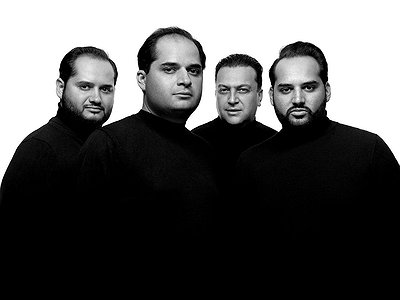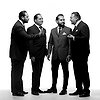Part 1
Name: Janoska Ensemble
Members: Ondrej Janoska, Julius Darvas, František Janoska, Roman Janoska
Nationality: Austrian
Current Release: “Revolution” on Deutsche Grammophone
Recommendations: Michelangelo – The creation of Adam
Johann Sebastian Bach - Air
Janoska Ensemble – Yesterday, from our new album Revolution
If you enjoyed this interview with the Janoska Ensemble, visit their website for music, videos, tour information and an expansive biography.
When did you start playing your instrument, and what or who were your early passions and influences? What is about music and/or sound that drew you to it?
We started playing our instruments when we were about 4 years old. We are the sixth generation of musicians in our family, so our parents and other family members were a huge source for inspiration. They always spread love and joy with their music. When we were children, we listened to all kinds of sounds, from Classical music, to Jazz, Pop and Folk music.
For most artists, originality is first preceded by a phase of learning and, often, emulating others. What was this like for you? How would you describe your own development as an artist and the transition towards your own voice? What is the relationship between copying, learning and your own creativity?
Of course, we each have our own musical role models. However, every member has created his own identity and tries to find new paths in music. We accomplish that by creating our own unique “Janoska Style,” which is our view on modern classical music. The city of Vienna has been a big influence for us since many great musicians have lived and worked here, not to mention the great flair and lifestyle the city has to offer. Copying someone else’s work is one thing, but creating music, inspired by our idols, is very personal. We believe every musician should have the goal to create something unique.
What were some of your main artistic challenges when starting out as an artist and in which way have they changed over the years?
We started the Janoska Ensemble with the mindset that we wanted to create something new. Using classical masterpieces as a foundation and evolving them with different kinds of improvisations and variations.
After all the years of playing together we have built up a level of trust, to the point that we don’t need to look at each other anymore, we simply know what the other member will play in the spontaneous moment.
Tell us about your studio/work space, please. What were criteria when setting it up and how does this environment influence the creative process? How important, relatively speaking, are factors like mood, ergonomics, haptics and technology for you?
When recording in a studio, we imagine we are performing for an audience so our music has a “live-effect”. We dim the light, just like it would be on a concert stage, and just let ourselves go with the music. We try to create our music in a way that people like hearing them when performed live.
For our new album, we created many pieces in the studio spontaneously, just like the Beatles did. We recorded the pieces for our new CD about three times and then used the best take.
Tell me about your instrument, please. What was your first instrument like and how did you progress to your current one? How would you describe the relationship with it? What are its most important qualities and how do they influence the musical results, including your own performance?
As children, we played with the instruments our parents gave us. Since there are numerous musicians in our family, we tried many different instruments. The search for the right instrument can be lengthy, but it is important, because you really need to unite with the instrument in order to play great music.
Roman and Ondrej Janoska play on Italian and Hungarian master violins, and their sounds match wonderfully. Frantisek Janoska is a Bösendorfer artist and Julius Darvas plays on a 150 years old Viennese double bass. It is important to have top-quality instruments, because when you play in a big hall, like Seoul Arts Center of Musikverein Vienna, the quality of the sound needs to be great from the first to the last row.
The relationship with an instrument is a deep one, since you are working with it every day – just like a marriage.






